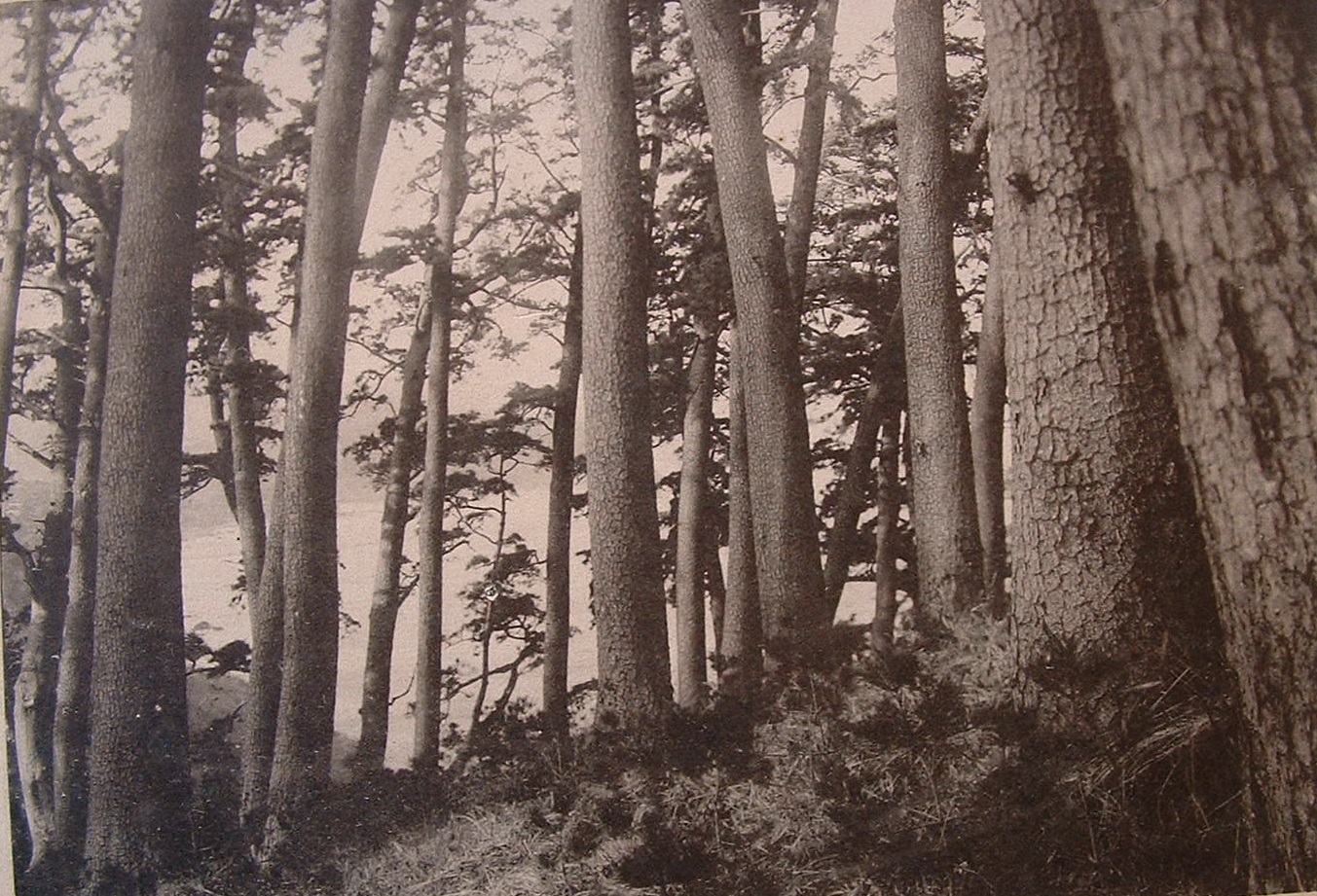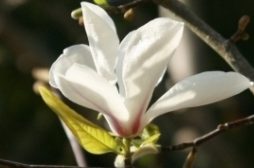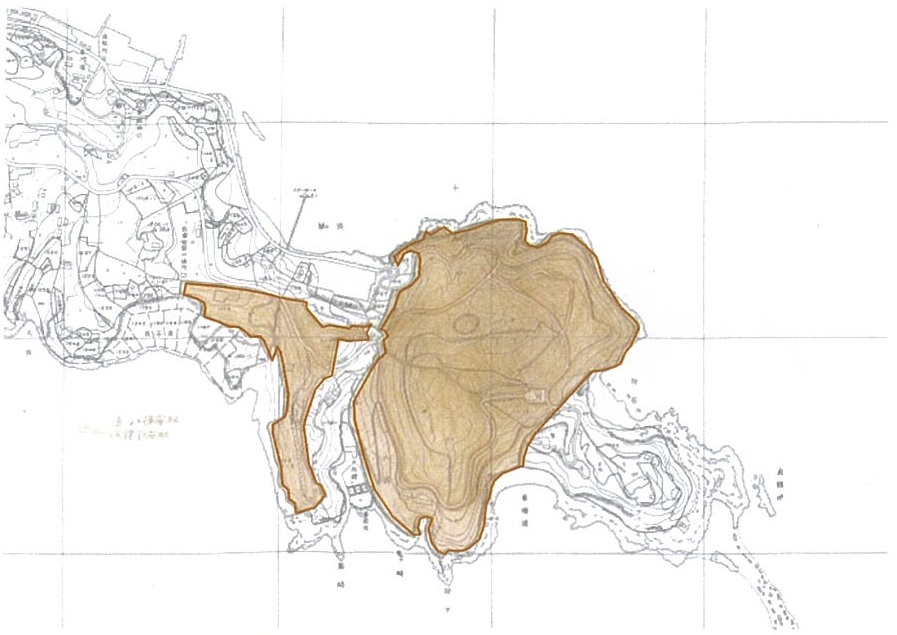| Manazuru (真鶴) Guide | Manazuru means “true crane.” The peninsula got its name because it supposedly looks like a crane with its wings outspread. Maybe if you squint? |
| First up: the beautiful Manazuru peninsula, on Saturday Oct. 3. | All that green at the right is the O-Hayashi (“Great Woods”), a forest that has remained undisturbed since the Edo period. That’s rare in Japan, where so many forests were burned for fuel during the war. |
| Manazuru is a very old town, traditionally centered on fishing and stone cutting. It is most famous for its Kibune Matsuri festival, held every July, and komatsu-ishi 小松石, a local stone used in constructing Edo Castle and many traditional Japanese gardens. (This stone was also used for the exterior walls of the Western-style house in the Kyu-Furukawa Garden in Tokyo, not to mention the outdoor tables at Roku Roku sushi restaurant in the Hyatt in Roppongi. How’s that for trivia?) The Mitsu-Ishi (“Three Rocks”) shrine at the tip of the peninsula. It’s possible to tip-toe out to it at low tide. | Today, Manazuru is known in city-planning circles for its emphasis on preserving local beauty and nature. In particular, it is noted for the O-Hayashi お林(“Great Woods”), a forest on the end of the peninsula that has been undisturbed since the Edo Period. We’ll start our tour of Manazuru with a ride on a sightseeing boat to get an overview of the peninsula from the water, passing rock quarries and commercial fishing sites with nets in the water. And we’ll get a great view of the O-Hayashi as well as the famous Mitsui Ishi (三ツ石) “Three Rocks”). |
| Having a woods so close to the ocean creates a unique eco-system because nutrients from the leaves dropped by the trees are carried by rain into the ocean, providing food for a wide range of fish. That’s why it’s also called the “uo-tsuki hayashi” 魚付き林 (“woods with fish”). | We’ll go into the woods in the company of the gūji 宮司 (priest) of Kibune Shrine 貴船神社 to an little branch shrine deep among the trees, where he’ll explain and demonstrate for us the Shinto rite that is performed there every year to protect the local fishermen and ensure good catches. |
真鶴半島 魚つき保安林「お林」
1 お林の歴史

御料林だったころのマツ林
江戸時代、明暦の大火により木材が大量に必要になったことから、幕命により小田原藩に割り当てられた15万本のマツ苗が萱原だった真鶴半島にも植林されました。明治維新後には、皇室御料林として一般の人は立ち入ることはできず、マツ林は見回り人により大切に保護されてきました。明治37年 森林法に基づく「魚つき保安林」に指定され、真鶴町漁業を支える大きな役割を担っています。
昭和22年 御料林は国有林となり、昭和27年には真鶴町に払い下げられ、マツだけではなくクスノキやスダジイなどの巨木が生い茂る混交林となり、真鶴町の神聖なる場所として大切に守られてきました。
昭和40年代に入ると全国的に「松くい虫」の被害が顕著となり、お林のマツも松くい虫被害の拡散を防ぐため、スプリンクラーによる薬剤散布や被害木の伐倒駆除、薬剤の樹幹注入を実施し、マツの保護に努めてきました。
お林を含む真鶴半島の先端部分は、海と沿岸部、そしてお林の連続性が一体となった生態系を有しており、豊かな自然環境の要素が詰まっています。
【お林のあゆみ】
◆ 1661年(寛文元年)小田原藩による松苗の植林。以後、立ち入り禁止の御留山となる。◆1800年後半 明治維新後、皇室「御料林」となる。 ◆ 1904年(明治37年) 森林法に基づく「魚つき保安林」に指定 ◆ 1947年 御料林は国有林となる。 ◆ 1952年 国有林が真鶴町に払い下げられ、移管される。 ◆ 1954年 「神奈川県立自然公園」に指定(特別地域48ha、普通地域90ha) ◆ 1960年「神奈川県立真鶴半島自然公園」に改称 ◆ 1963年「真鶴サボテンドリームランド」開園 ◆1979年 かながわの景勝地50選「真鶴岬と三ツ石」 神奈川県指定天然記念物「真鶴半島沿岸に生息するウメボシイソギンチャクとサンゴイソギンチャク」 ◆ 1984年かながわの名木100選「真鶴半島のクロマツ」 ◆ 1986年 森林浴の森100選「真鶴岬」 ◆ 1988年 かながわの美林50選「真鶴半島の森」 ◆ 1989年(平成元年)「中川一政美術館」開館 ◆ 1991年 かながわの探鳥地50選「真鶴岬」 ◆ 1994年 かながわの花の名所100選「真鶴半島のガクアジサイ」 ◆ 2001年 日本の重要湿地500選(真鶴岬周辺沿岸部) ◆ 2004年 「ケープ真鶴」営業開始(旧 小田急ケープパレス) ◆ 2005年 「お林展望公園」開園(旧 真鶴サボテンドリームランド) ◆ 2006年 ✿「未来に残したい漁業漁村の歴史文化財百選「 ✿ 魚つき保安林と小早船」 ◆ 2007年 松くい虫被害対策事業 薬剤の樹幹注入へ完全移行 ◆ 2009年「遠藤貝類博物館」開館(ケープ真鶴併設) 神奈川県指定天然記念物「真鶴半島の照葉樹林」
5 お林保全方針 ~お林の基本的な考え方~
お林保全協議会では、令和元年7月30日に開催した「第4回 真鶴町お林保全協議会」で、ワーキンググループから提出された報告書をもとに「お林保全方針~お林の基本的な考え方~」を策定しました。
このお林保全方針は、令和元年度実施予定の「お林調査」や「お林保全シンポジウム」を通して町民の皆さんに周知し、年度末には町の「お林保全方針」として定める予定です。


